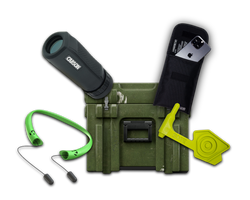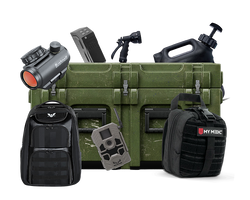What is a Designated Marksman Rifle? Understanding the DMR in Tactical Applications
Table of Contents
- Introduction
- What Defines a Designated Marksman Rifle?
- Historical Context of the Designated Marksman Rifle
- Comparing DMRs to Other Firearms
- Popular Designated Marksman Rifle Platforms
- The Civilian Market for DMRs
- Conclusion
- FAQ
Introduction
Imagine a battlefield where precision meets versatility, a realm where the stakes are high, and the right equipment can make all the difference. This is the environment that the designated marksman rifle (DMR) is built for. As military engagements evolve, so do the tools used by soldiers. The DMR fills a critical gap between standard infantry rifles and dedicated sniper systems, enabling infantry squads to extend their effective range without sacrificing the rapid engagement capabilities necessary in combat.
The designated marksman role emerged from the need for a weapon that could deliver high accuracy at extended ranges—typically between 300 to 600 meters. With its semi-automatic action and larger magazine capacities, the DMR allows for quick follow-up shots and the ability to engage multiple targets swiftly. This blog post aims to delve into the intricacies of what a designated marksman rifle is, exploring its features, historical context, operational roles, and popular models in both military and civilian applications.
By the end of this post, you will have a comprehensive understanding of DMRs, their significance in tactical scenarios, and how they compare to other firearms such as sniper rifles and standard infantry rifles. We will also highlight some of the best DMR platforms available today, illustrating how they cater to various needs in both military and civilian contexts.
What Defines a Designated Marksman Rifle?
Core Characteristics of DMRs
A designated marksman rifle is not just any rifle; it has specific features that differentiate it from other firearms:
-
Action Type: Unlike traditional sniper rifles, which are predominantly bolt-action, DMRs are primarily semi-automatic. This design allows for quicker follow-up shots, making them suitable for scenarios requiring rapid engagement of multiple targets.
-
Effective Range: DMRs excel at engaging targets within a range of 300 to 600 meters. They are designed to deliver accuracy and terminal ballistics that surpass those of standard assault rifles but do not reach the extended range capabilities of dedicated sniper rifles.
-
Caliber: Most DMRs are chambered in full-power rifle cartridges. Common calibers include 7.62 NATO and .308 Winchester, which provide the necessary stopping power and range. Some modern DMRs also utilize the 6.5 Creedmoor caliber for its enhanced ballistic performance.
-
Optics: DMRs are typically equipped with advanced optical sighting systems that offer higher magnification than standard infantry rifles. This allows for improved target acquisition and precision at extended ranges.
-
Ergonomics and Stability: Many DMRs feature adjustable stocks and bipods to enhance stability and control, providing the marksman with the best possible platform for accurate shooting.
The Role of Designated Marksmen in Military Operations
The designated marksman fills an essential role within infantry squads. Often the best shot in their unit, a designated marksman is tasked with engaging enemy targets at greater distances than standard infantrymen can effectively manage. This capability helps to:
-
Extend Squad Range: By providing accurate fire at extended ranges, designated marksmen can influence the battlefield by engaging threats that would otherwise be out of reach for standard infantry rifles.
-
Provide Suppressive Fire: DMRs can deliver accurate fire to suppress enemy movements, providing cover for the squad to maneuver or retreat as necessary.
-
Enhance Target Discrimination: The precision offered by DMRs allows designated marksmen to engage high-value targets, such as enemy snipers or commanders, without putting their squad at greater risk.
Historical Context of the Designated Marksman Rifle
Origins and Evolution
The concept of a designated marksman rifle is relatively modern, emerging in response to the changing dynamics of warfare. The U.S. military began to explore the need for an intermediate weapon that could bridge the gap between standard infantry rifles and sniper systems in the 1960s. Early iterations included accurized versions of existing rifles, such as the M14, which was modified to serve in the designated marksman role.
-
Vietnam War Era: During the Vietnam War, the U.S. military recognized the utility of marksmen who could engage enemy combatants at longer ranges than standard infantry capabilities allowed. The M14 was one of the first rifles adapted for this role, equipped with optics for improved accuracy.
-
Post-9/11 Conflicts: The need for DMRs became particularly apparent in the post-2000 conflicts, notably in Afghanistan. As enemy forces adapted and began utilizing body armor, the limitations of standard infantry rifles became evident. The U.S. military and its allies sought to upgrade their capabilities by adopting DMRs that could engage targets effectively at greater distances.
Modern Developments
As the demand for precision in warfare continues to grow, so too does the technology surrounding designated marksman rifles. Innovations include:
-
Enhanced Optics: The integration of advanced optics allows DMRs to maintain accuracy even at extended ranges, with features such as variable magnification and reticle illumination.
-
Modular Designs: Many modern DMRs are built on modular platforms that allow for customization tailored to specific operational requirements. This includes adjustable stocks, rail systems for accessories, and the ability to switch barrel lengths.
-
Caliber Innovations: The introduction of new calibers like the 6.5 Creedmoor has expanded the capabilities of DMRs, providing superior ballistic performance and accuracy over traditional rounds.
Comparing DMRs to Other Firearms
DMRs vs. Sniper Rifles
While both DMRs and sniper rifles serve the purpose of engaging targets at extended ranges, they are designed for different roles:
-
Action Type: Sniper rifles are typically bolt-action, prioritizing maximum accuracy, while DMRs are semi-automatic, emphasizing a balance between speed and precision.
-
Effective Range: Sniper rifles excel at longer ranges, often exceeding 800 meters, while DMRs are optimized for a narrower range of 300 to 600 meters.
-
Fire Rate: DMRs are capable of delivering rapid fire, making them effective in situations requiring quick follow-up shots, whereas sniper rifles are better suited for single, precise shots.
DMRs vs. Standard Infantry Rifles
The differences between DMRs and standard infantry rifles are also notable:
-
Accuracy: DMRs are designed for much higher accuracy, often featuring enhanced barrels and optics.
-
Range: Standard infantry rifles, like the M4 carbine, are effective at close to medium ranges, while DMRs extend the engagement capability of a squad.
-
Ammunition: DMRs are often chambered in more potent calibers that provide better performance at distance, whereas standard rifles usually fire intermediate cartridges like the 5.56 NATO.
Popular Designated Marksman Rifle Platforms
Several models of DMRs are popular within military and civilian contexts, each offering different features tailored to specific needs:
1. M14 EBR (Enhanced Battle Rifle)
The M14 EBR has been a staple in the U.S. military as a designated marksman rifle. It is a modified version of the M14, featuring a modular stock system that enhances ergonomics and stability. The EBR is chambered in 7.62 NATO and is equipped with advanced optics, making it an effective choice for long-range engagements.
2. Mk 12 Special Purpose Rifle
The Mk 12 SPR is built on the AR-15 platform and is designed for precision shooting at distances up to 600 meters. It uses a 5.56 NATO caliber and is equipped with high-quality optics. This rifle is favored for its lightweight design and ease of handling.
3. SCAR-H (FN SCAR 17S)
The SCAR-H is a versatile rifle that can serve in various roles, including that of a DMR. It is chambered in 7.62 NATO and features a gas-operated system, allowing for reliable operation in diverse conditions. Its modular design allows for extensive customization, making it a popular choice among military and civilian shooters alike.
4. SR-25
The SR-25 is another semi-automatic rifle that can serve as a designated marksman rifle. It is known for its accuracy and is chambered in 7.62 NATO. The SR-25 features a free-floating barrel and a solid rail system for mounting optics and accessories, enhancing its versatility.
5. L129A1 Sharpshooter Rifle
Adopted by the British Army, the L129A1 is a semi-automatic rifle that operates in the 7.62 NATO caliber. It is known for its accuracy and effectiveness in the 600-800 meter range. The L129A1 has been deployed successfully in various combat scenarios, proving its reliability.
6. G28 (HK417)
The G28 is a designated marksman rifle used by the German Army, based on the HK417 design. It combines precision and versatility, making it effective for long-range engagements. The G28 is adaptable to various optics and accessories, enhancing its functionality in the field.
The Civilian Market for DMRs
With the growing interest in shooting sports and tactical training, designated marksman rifles have gained popularity among civilian enthusiasts. Many of the military platforms mentioned above have civilian variants that offer similar features while adhering to legal regulations.
Building Your Own DMR
For those interested in creating a DMR for civilian use, platforms such as the AR-10 or the M1A provide excellent bases for customization. Here are some tips for building your own DMR:
-
Choose the Right Caliber: Opt for a caliber that suits your intended use, whether it be hunting, competition, or recreational shooting. Common choices include 7.62 NATO and .308 Winchester.
-
Select Quality Optics: Invest in high-quality optics that offer variable magnification and clear reticles for improved target acquisition.
-
Prioritize Stability: Use a bipod or adjustable stock to enhance stability and comfort while shooting.
-
Consider Modular Options: Platforms like the AR-10 allow for extensive customization, enabling you to tailor the rifle to your specific preferences and needs.
Conclusion
The designated marksman rifle is a vital component of modern military strategy, bridging the gap between standard infantry rifles and sniper systems. By understanding what a DMR is, its historical context, and its operational significance, you can appreciate its role in enhancing a squad's effectiveness on the battlefield.
Whether you are a tactical enthusiast, a competitive shooter, or someone interested in preparedness, the DMR represents a versatile option that can serve multiple purposes. With an array of platforms available today, you can find a designated marksman rifle that meets your needs, whether for military applications or civilian use.
As you consider adding a DMR to your collection or enhancing your tactical skills, remember that the right gear, coupled with training, is essential for maximizing your effectiveness in any situation.
FAQ
1. What is the primary purpose of a designated marksman rifle? The primary purpose of a designated marksman rifle is to provide infantry squads with the ability to engage targets at extended ranges, typically between 300 to 600 meters, with high accuracy and rapid follow-up shots.
2. How does a DMR differ from a sniper rifle? A DMR is typically semi-automatic and designed for faster engagements, while sniper rifles are often bolt-action and optimized for maximum accuracy at longer distances.
3. What calibers are commonly used in designated marksman rifles? Common calibers for DMRs include 7.62 NATO, .308 Winchester, and 6.5 Creedmoor, offering a balance of range, accuracy, and stopping power.
4. Can civilians own designated marksman rifles? Yes, many military DMR platforms have civilian variants available for purchase, allowing enthusiasts to engage in shooting sports and tactical training.
5. What are some popular designated marksman rifle platforms? Popular DMR platforms include the M14 EBR, Mk 12 Special Purpose Rifle, SCAR-H, SR-25, L129A1, and G28, each offering unique features and capabilities.
For those looking to equip themselves with quality tactical gear, consider subscribing to Crate Club to receive curated selections of survival tools and equipment that will enhance your readiness. Explore our offerings and build your collection today: Crate Club Subscription Services and Crate Club Shop.
แบ่งปันบทความนี้



